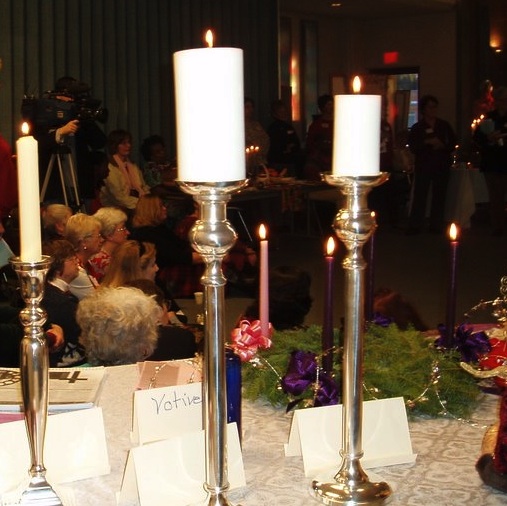Our multifaith, multicultural meeting was ablaze with color and light and warmed by music, song and dance. Women of seven traditions arranged tables with food, cloths, candles, and other festive items that illustrate their spiritual celebrations as expressed through the metaphor of light. Members were able to sample festive foods and ask questions about the items at the tables representing Bahá’í, Christianity, Hinduism, Islam, Judaism, Kwanzaa and Wicca. Some of the traditions also entertained us with traditional music or dance.
Bahá’í—Cher Fortune
This table was very popular, not least because of the wonderful desserts! Cher answered questions and explained that Bahá’ís consider knowledge and education to be light in our lives. Bahá΄u΄lláh said, “You are my lamp, my light is in thee.” His sayings echo many of the metaphors of light familiar to other religions. The light should show in our lives.
Christianity—Janet Donoghue
Janet coordinated this table with its many candles: votives to be lit in either gratitude or supplication; a large paschal candle used throughout the Easter season; sanctuary candles; an Advent wreath with four candles that are lit during the four weeks prior to Christmas; and a unity candle used at weddings. Christians consider Christ to be “the light of the world.”
Hinduism—Smita Rane
This table had illustrations depicting the multitude of small lamps, called diyas, that are lit during Diwali, the Hindu festival of lights. Smita explained that these lamps are considered to be the lighted pathway of a person’s expression of happiness and a way of paying obeisance to God. Smita introduced Sudha Raj, a teacher of South Indian classical dance, also known as bharata natyam. The dances are based on Hindu scripture and legends and use footwork, hand and facial gestures, and head, neck and eye movements to enact these stories. Sudha introduced her teenage daughter, Minakshi, who has been studying dance since she was five years old. Minakshi wore a beautiful green-and-orange dance costume, with fan pleats in the front, and bells on her ankles. As Minakshi performed a temple dance, we were fascinated by the movement of her hands and head, the opening and closing of her fan pleats, and the gentle jingle of her bells.
Judaism—Ann Eppinger Port & Francine Berg
Ann and Francine, who is cantor of Temple Society of Concord, answered questions and explained the various items at this table: a traditional, seven-branched temple menorah and a nine-candle menorah for Hanukkah; Shabbat candles that are lit at the beginning of the Sabbath and braided Havdalah candles that are lit at the end; and Yahrzeit (memorial) candles lit on the anniversary of the death of a loved one. There were also a variety of dreidels, or four-sided spinning tops, and Hanukkah gelt (money) in the form of gold foil–covered chocolate coins. In Genesis, the first book of the Bible, God said, “Let there be Light”; and now in every synagogue, an eternal light (ner tamid) hangs above the ark that houses the Torah scrolls. Francine sang “Light One Candle,” and Renee-Noelle Felice led everyone in singing a round.
Kwanzaa—Akosua
Kwanzaa uses light to celebrate spirituality, family values, and community responsibility. Akosua explained the traditions of Kwanzaa, an African-American celebration started in the 1960s to recognize and honor people’s African and American identities. Kwanzaa is observed from December 26 to January 1.
There are seven principles of Kwanzaa, which are represented by seven candles: three red candles for the blood shed to claim freedom, one black candle for African heritage, and three green candles to represent the gifts of the earth. The seven principles are unity, self-determination, work, economic interdependence, purpose, creativity, and faith. The items used to celebrate Kwanzaa should be handmade, as should gifts given to others. The final day of Kwanzaa, Karamu, is celebrated with a feast.
Islam—Danya Wellmon & Magda Bayoumi
The Qur’an tells us that “God is the light of the heavens and the earth.” This light is spiritual, independent of the physical restrictions of space and time. Danya explained that angels were created from light. She displayed information about Ramadan, the hajj, and light shining from minarets.
Danya introduced several Pakistani women who wore beautiful ethnic dresses and demonstrated traditional singing, drumming and clapping, such as are done at weddings. Danya played a tape of Yusuf Islam, formerly known as Cat Stevens, singing “God is the Light.”
Magda wore an all-white hajj outfit. She explained that all the men—and many of the women—on hajj wear the same outfit, symbolizing that despite human differences of wealth or power, all believers are equal before God. The clothes of both men and women fully cover the body and are loose and flowing.
Wicca—Terra Harmatuk & Julie Statzler
Terra and Julie created a festive table, arranged in celebration of the winter solstice. They showed us a decorated Yule log. They explained the meaning of four candles that symbolize the four directions and denote the classic elements and attributes: a yellow candle (east) that represents air, mind and knowledge; a blue candle (west), water and emotions; a green candle (north), earth; and a red candle (south), spirit and fire. They showed us other candles that represent the aspects of the Goddess: a white candle, the maiden; a red candle, the mother; a black candle, the crone. Two other candles denote the aspects of God: red for the Holly King and green for the Oak King.
Many of the traditions provided handouts for us to take with us. We rejoiced in each other’s unique celebrations and values, yet came away impressed by how much we all have in common. We left energized in mind and heart, still savoring the flavors, sights and sounds of our gathering. We truly are the light in each other’s lives.

